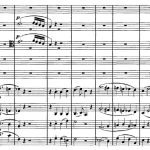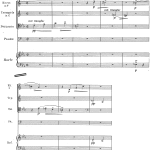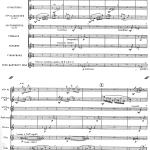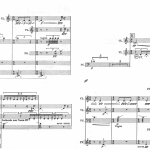Figure 34 · Mozart, Symphony No. 40, 1st movement, m 44
The above example demonstrates what may be referred to as “split orchestration.” The melody alternates between strings and woodwinds, and the sonority changes accordingly, but the melodic identity is not threatened – the segment is perceived as a single voice or line.
From here on, the term unisono will be used to identify musical elements that in a broader sense behave as one voice or line. Thus, the traditional meaning of the term is extended to include all situations in which different elements collectively form a distinct and unified voice or line (or even an entire musical texture).
The opening theme of Mozart’s symphony No. 40 is presented as a single line in the violins (cf. figure 30), whereas the second theme (figure 34) is divided into separate phrases. Here it is useful to distinguish between linear unison (first theme) and split unison (second theme).
In Anton Webern’s famous 1935 orchestration of Bach’s six-part “Ricercare” from Musikalisches Opfer, the contrapuntal lines constantly change tone color and/or articulation, so that the perception of individual lines is nearly eliminated in favor of points of ever-changing tone color. Webern was strongly influenced by the concept of Klangfarbenmelodie (“tone-color melody”) introduced by Arnold Schoenberg in his textbook on harmony, published in 1911. Schoenberg himself used the concept to describe a musical line with continuously changing tone colors, as well as the constantly changing sonority of chords in “Farben”(colors), the third movement of his Five Pieces for Orchestra, 1909 (cf. figure 97 and figure 98).
Figure 35 · Bach/Webern, Das Musikalische Opfer, Ricercare, m. 1
The Messiaen example below can easily be seen as an extension of “split orchestration.”
Figure 36 · Messiaen, Turangalîla Symphony (1948), 9th movement, m. 1
In the following example, Italian composer Niccolò Castiglioni crafts an altogether monophonic Klangfarbenmelodie by letting – chameleon-like – a single note change tone color as part of an ongoing process.
Figure 37 · Castiglioni, Tropi (1959), 4 m. before G
Countless examples of “split orchestration” can be found especially in the classical literature, not least in musical situations based on the idea of “question and answer” between different groups of instruments. But linear unison is by far the most frequent, and will therefore act as the basis for the following discussions and examples involving doubling.
We will examine various doubling strategies, some of which may also occur in split orchestration. The division into separate doubling types is not intended to establish rigid definitions, but to present a basic overview. In practice, the individual types will to a certain degree overlap or converge.
· · ·
Next · Perfect Unison (Chapter 4. Unisono and Doubling)



